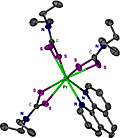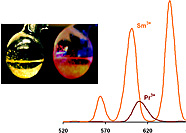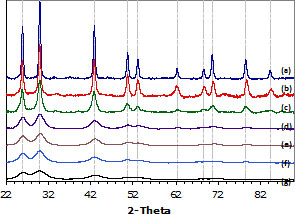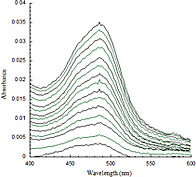|
Generally our group is interested in magnetic, optical or electronic properties of materials and nanoparticles. Many projects are focused on magnetic nanoparticles and clusters, but optical and electronic properties are often involved. Air-sensitive synthetic techniques as well as hydrothermal, molten salt, and layer-by-layer methods are employed as needed.
Precursors for Lanthanide Sulfide Nanoparticles
We have used lanthanide dithiocarbamate complexes as precursors for forming nanoparticles of Ln-S materials. We are interested in optical, electronic, magnetic and valency in the monochalcogenides LnS.
Although the lanthanides are well known for their luminescent properties, these complexes exhibited unusual luminescence because the bright emitters were found for Sm, Pr and only weakly in the most common emitter Eu and not at all in Dy or Tb. |
 |
 |
Nanocrystals of Magnetic Semiconductors
We have been interested in studying size dependent magnetism in magnetic semiconductors. Our model systems are based on europium monochalcogenides, EuS, EuSe. The ferromagnetic coupling depends on the extent of f electron delocalization.
We found that both band gap tuning and surface effects could explain the variation of the ferromagnetic ordering on EuS nanoparticles. |
 |
Surface attached Mn-12
The magnetic manganese-oxo cluster, known as "Mn-12" (Mn12O12Ac16), has been of interest for its novel magnetic properties including an unusually large spin state, and steps in the magnetization versus field. We have used different organic templates (Self-Assembled Monolayers and polyanions such as PAA) to tessellate Mn-12 on substrates forming monolayer and multilayer thin films.
More recently we have developed a method for co-polymerizing the cluster with monomers such as styrene and acrylate. |
 |
 |
Hydrothermal Synthesis
| We have used hydrothermal synthesis to crystallize metal framework materials searching for new materials with optical, electronic or magnetic behavior. We have studied the luminescent properties of materials including the copper halides and cyanides with bifunctional ligands. |
|
 |
|






